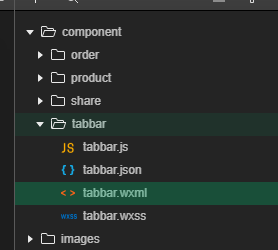先说说遇到的问题
当使用微信原生的tabBar时,tabBar是固定在最下面 ,并且层级最高。当我想做一个弹窗时 tabBar还是会显示在最上面,弹窗覆盖不了。当时想到了显示弹窗时 使用wx.hideTabBar();先隐藏tabbar 当弹窗关闭时在wx.showTabBar();显示;
如果这样会遇到另外一个问题 显示tabbar 和隐藏tabbar 页面page 的高度是不同的 当你这样控制tabbar时 页面就会有闪烁
解决:
在app.json 中还是定义tabbar 在进程序时就先隐藏 onShow(){ wx.hideTabBar(); };
自己定义tabbar组件,切换tabbar页时调用 wx.switchTab({url: ''})
为什么还要定义系统tabbar ,怎么不直接使用自定义的tabbar呢
因为 自定义的tabbar 在页面切换的时候会发现有空白页闪烁 感觉页面的切换不流畅 所以需要有原生tabbar 用它去切换没有空白页闪烁问题。
不知道我遇到的问题,大家有没有遇到过哦,或者是我的代码哪里有问题造成这样的,反正我靠这样的思路解决了我说的问题 下面贴代码
1.app.json中创建tabbar
"tabBar": {
"color": "#515151",
"selectedColor": "#FE6531",
"borderStyle": "white",
"list": [
{
"selectedIconPath": "images/tabbar/home-active.png",
"iconPath": "images/tabbar/home.png",
"pagePath": "pages/index/index",
"text": "首页"
},
{
"selectedIconPath": "images/tabbar/list-active.png",
"iconPath": "images/tabbar/list.png",
"pagePath": "pages/category/category",
"text": "分类"
},
{
"selectedIconPath": "images/tabbar/cart-active.png",
"iconPath": "images/tabbar/cart.png",
"pagePath": "pages/shoppingCart/shoppingCart",
"text": "购物车"
},
{
"selectedIconPath": "images/tabbar/user-active.png",
"iconPath": "images/tabbar/user.png",
"pagePath": "pages/user/user",
"text": "用户"
}
]
}
2.自定义tabbar组件 (注意我用到是组件 ,这样想在哪个页面使用都可以)

tabbar.wxml
<view class="w-tabbar ">
<block wx:for="{{tabars}}" wx:key="{{index}}">
<view bind:tap="onTabbar" data-index="{{index}}">
<image src="{{activeIndex == index ? item.selectedIconPath : item.iconPath}}"></image>
<view class="{{activeIndex == index ? 'active' : '' }}">{{item.text}}</view>
<text class="tabbar-sign" wx:if="{{signIndex == index}}">{{signContent}}</text>
</view>
</block>
</view>
注释:activeIndex是传进来的下标 表示显示的是哪个页面 会显示激活的图片 和 激活颜色的文字
tabbar-sign 是标记 我这里是有购物车 可以在购物车右上角显示一个带数量的标记 大家可以看最后的效果图就明白了
tabbar.js
// component/tabbar/tabbar.js
Component({
/**
* 组件的属性列表
*/
//使用组件页面传递过来的属性
properties: {
activeIndex:{ //激活页面的index (激活会显示带有颜色的图标,带颜色的文字)
type:String,
default:''
},
signIndex:{ //标记 第几个tabbar右上角有标记
type: String,
default: '9'
},
signContent: { //标记的内容
type: String,
default: ''
},
},
/**
* 组件的初始数据
*/
data: {
tabars:[
{
"selectedIconPath": "/images/tabbar/home-active.png",
"iconPath": "/images/tabbar/home.png",
"pagePath": "/pages/index/index",
"text": "首页"
},
{
"selectedIconPath": "/images/tabbar/list-active.png",
"iconPath": "/images/tabbar/list.png",
"pagePath": "/pages/category/category",
"text": "分类"
},
{
"selectedIconPath": "/images/tabbar/cart-active.png",
"iconPath": "/images/tabbar/cart.png",
"pagePath": "/pages/shoppingCart/shoppingCart",
"text": "购物车"
},
{
"selectedIconPath": "/images/tabbar/user-active.png",
"iconPath": "/images/tabbar/user.png",
"pagePath": "/pages/user/user",
"text": "分类"
}
]
},
/**
* 组件的方法列表
*/
methods: {
onTabbar:function(e){
let index = e.currentTarget.dataset.index;
//点击tabbar时将事件发送到 使用tabbar的页面 (事件回调)
this.triggerEvent("onTabbar",
{ data: this.data.tabars[index].pagePath},
{}
)
}
}
})
tabbar.wxss
/* component/tabbar/tabbar.wxss */
.w-tabbar{
position: fixed;
left:0;
bottom:0;
width:100%;
height:100rpx;
background: #fff;
display: flex;
padding-top:14rpx;
}
.w-tabbar>view{
flex:1;
text-align: center;
position: relative
}
.active{
color:#FE6531;
}
.w-tabbar image{
width:52rpx;
height:52rpx;
}
.w-tabbar>view view{
font-size: 20rpx;
position: relative;
top:-6rpx;
}
.tabbar-sign{
width:30rpx;
height:30rpx;
background: #FE6531;
color:#fff;
text-align: center;
line-height:30rpx;
font-size: 20rpx;
position: absolute;
right:60rpx;
top:-6rpx;
border-radius: 50%;
}
3.在index.wxml中使用tabbar (使用分两步 1.在index.json中引用 2.使用 )
indxe.json
{
"usingComponents": {
"w-product":"/component/product/product",
"w-share":"/component/share/share",
"w-tabbar":"/component/tabbar/tabbar" //在这里 其余代码大家不用管 有这行就可以
},
"navigationStyle":"custom"
}
index.wxml (ontabbar是返回的事件)
<w-tabbar signIndex="2" signContent="2" activeIndex="0" bind:onTabbar="onTabbar"/>
index.js
onShow:function(){
wx.hideTabBar() //隐藏原生的tabbar
},
onTabbar:function(e){ //自定义tabbar的回调事件
let path = e.detail.data;
wx.switchTab({url: path}) // 使用wx.switchTab切换页面 专门用来跳转tabBar的
},
到这里就结束了 有不足的地方或者有更好的思路 欢迎大家留言 最后贴个效果图吧





 本文介绍了在微信小程序中遇到的自定义TabBar问题,即原生TabBar在弹窗场景下层级过高。作者提出通过在onShow时隐藏TabBar以解决弹窗覆盖问题,但这种方法会导致页面闪烁。为解决这个问题,作者选择同时定义原生和自定义TabBar,利用原生TabBar进行平滑页面切换,而自定义TabBar提供更灵活的布局。文章提供了实现步骤和相关代码片段。
本文介绍了在微信小程序中遇到的自定义TabBar问题,即原生TabBar在弹窗场景下层级过高。作者提出通过在onShow时隐藏TabBar以解决弹窗覆盖问题,但这种方法会导致页面闪烁。为解决这个问题,作者选择同时定义原生和自定义TabBar,利用原生TabBar进行平滑页面切换,而自定义TabBar提供更灵活的布局。文章提供了实现步骤和相关代码片段。
















 8176
8176

 被折叠的 条评论
为什么被折叠?
被折叠的 条评论
为什么被折叠?








